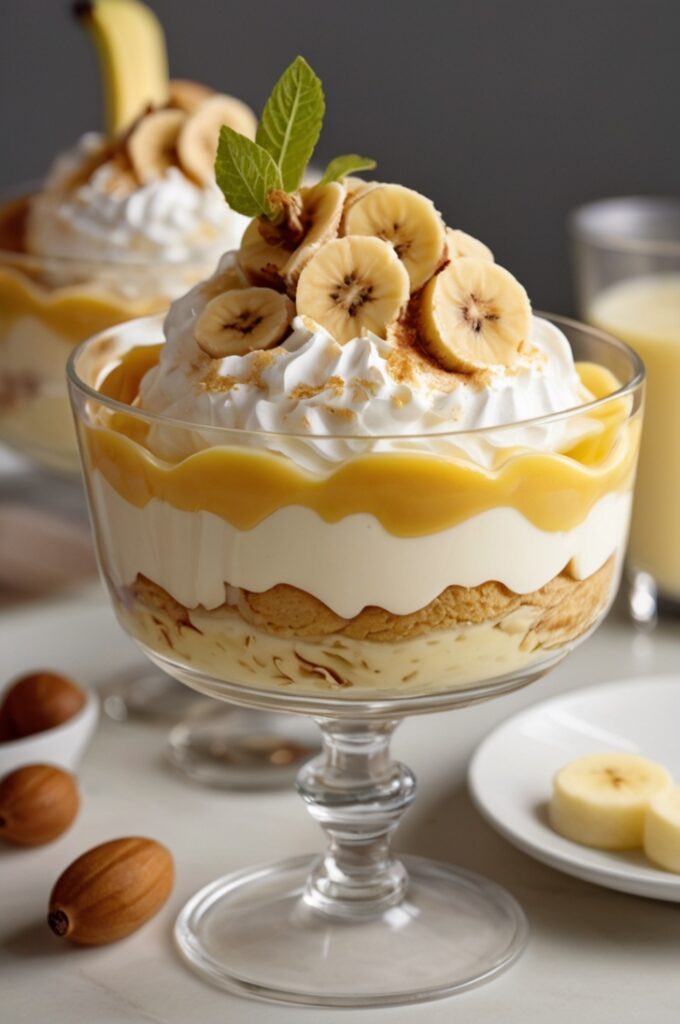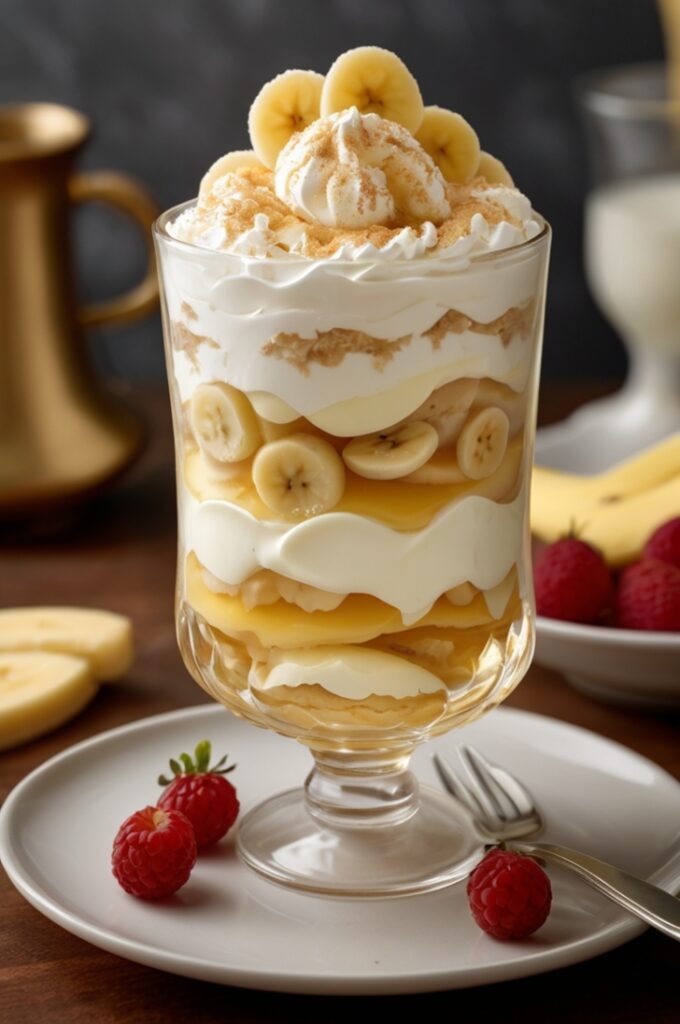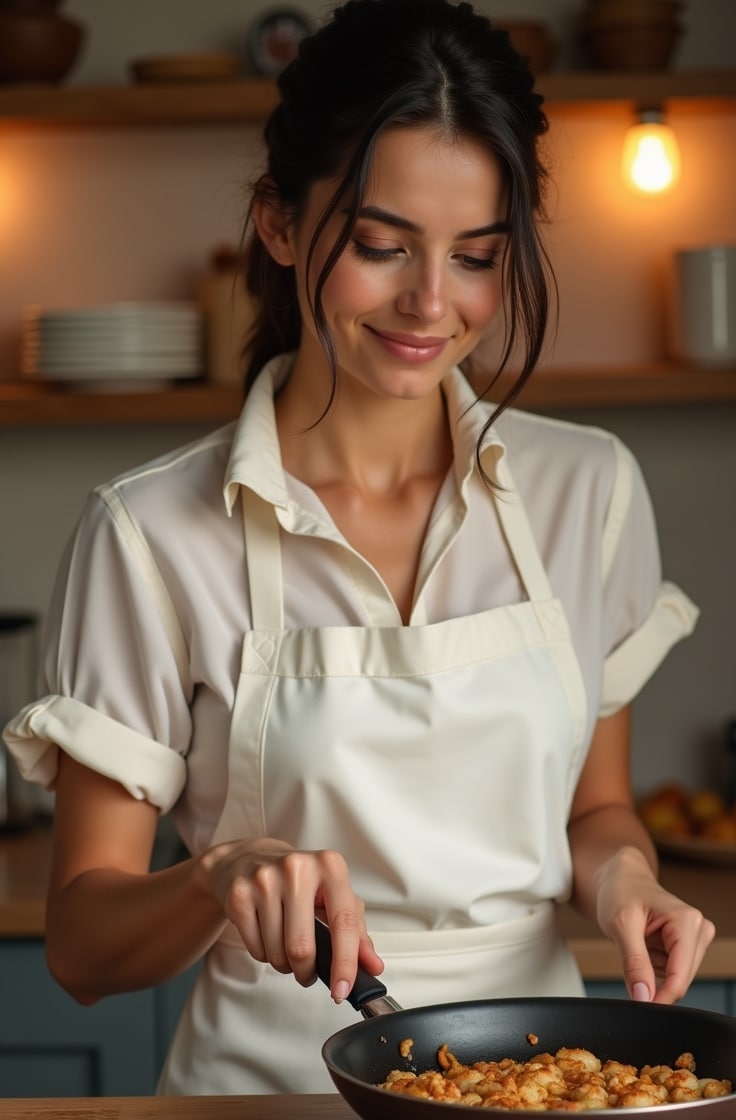I still remember my grandmother’s hands, dusted with flour and vanilla wafer crumbs, layering her famous banana pudding in that blue ceramic dish. The one with the chip on the handle. That dessert tasted like summer evenings on the porch, like childhood itself. Y’all, I’ve spent twenty years as a pastry chef tryna recreate that magic, and I’m finally ready to share my definitive guide to creating the most authentic, soul-satisfying banana pudding you’ll ever taste.
Let me tell you somethin’ – this ain’t your box-mix pudding. This is the real deal. The kind that makes people close their eyes when they take that first bite. The kind that gets requested at every family reunion. The kind worth mastering.
What Makes This Banana Pudding Special
Traditional Southern banana pudding combines a silky vanilla custard with layers of sweet bananas and vanilla wafers, all topped with a cloud of meringue or whipped cream. But my version elevates the classic with a few chef-inspired techniques. We’re using real vanilla beans instead of extract. We’re making our own vanilla wafers (trust me, it’s worth it). And we’re caramelizing some of the bananas for an extra dimension of flavor that’ll make folks wonder what your secret is.
The beauty of this dessert lies in its contrasts. Crisp cookies softening into cake-like layers. Firm bananas yielding their sweetness to the custard. A delicate balance between comfort and sophistication that few desserts achieve.
1. Ingredients & Substitutions
For the Vanilla Custard:
- 6 large egg yolks (save whites for meringue)
- 1 cup granulated sugar
- ¼ cup cornstarch
- ½ teaspoon kosher salt
- 4 cups whole milk
- 2 vanilla beans, split and scraped (or 1 tablespoon vanilla bean paste)
- 4 tablespoons unsalted butter, cubed and cold
Whole milk creates the richest custard, but you could substitutte half-and-half for an even more decadent result. If you’re lactose-sensitive, oat milk works surprisingly well – it’s got the right fat content and natural sweetness. For vanilla, beans provide those gorgeous black flecks and unparalleled flavor, but good-quality extract (2 tablespoons) can pinch hit in a emergency.
For the Homemade Vanilla Wafers:
- 1½ cups all-purpose flour
- ¾ teaspoon baking powder
- ¼ teaspoon kosher salt
- ½ cup unsalted butter, room temperature
- 1 cup granulated sugar
- 1 large egg
- 1 tablespoon vanilla extract
- 2 tablespoons whole milk
Don’t have time to make wafers? Store-bought works, but look for the premium ones with real vanilla – they’re usualy found in the gourmet section. Shortbread cookies or even ladyfingers can work in a pinch, though they’ll change the texture profile.
For Assembly:
- 6-7 ripe bananas (some firm, some with small brown spots)
- 2 tablespoons unsalted butter (for caramelized bananas)
- 1 tablespoon dark brown sugar (for caramelized bananas)
- 2 tablespoons dark rum (optional, for caramelized bananas)
For the Meringue Topping:
- 6 egg whites (reserved from custard)
- ¼ teaspoon cream of tartar
- ½ cup granulated sugar
- 1 teaspoon vanilla extract
Not a meringue fan? Substitute 2 cups of heavy cream whipped with ¼ cup powdered sugar and 1 teaspoon vanilla. Some folks in my classes even prefer this lighter option.
2. Step-by-Step Instructions

Making the Custard:
- In a heatproof bowl, whisk together the egg yolks until smooth. Set aside, but keep that whisk handy. The yolks need to be room temperature to prevent curdling when we add them to the hot milk mixture later.
- In a heavy-bottomed saucepan, whisk together the sugar, cornstarch, and salt. The cornstarch prevents the eggs from scrambling, so don’t skimp here.
- Gradually add the milk to the dry ingredients, whisking constantly to prevent lumps. Those lumps are the enemy of silky-smooth pudding, so take your time with this step.
- Add the vanilla beans (pod and seeds) to the milk mixture and heat over medium, stirring constantly with a wooden spoon or heat-resistant spatula. You gotta keep stirring – custard can scorch faster than you’d think.
- When the mixture starts steaming and small bubbles form around the edges (about 5-7 minutes), it’s gettin’ close. Don’t let it boil! The ideal temperature is around 180°F if you’re using a thermometer.
- Here’s where most people mess up: temper the egg yolks by slowly ladling about 1 cup of the hot milk mixture into them while whisking vigorously. This prevents scrambled eggs in your pudding – nobody wants that surprise.
- Pour the tempered egg mixture back into the pot, whisking constantly. Cook over medium-low heat, still stirring constantly, until the custard thickens enough to coat the back of a spoon and hold a line when you run your finger through it (about 3-4 minutes).
- Remove from heat and stir in the cold butter cubes until melted. The butter adds a silky texture and helps prevent skin from forming on the custard.
- Strain the custard through a fine-mesh sieve into a clean bowl to catch any lumps or bits of egg that might have coagulated. This step seems fussy but it’s what separates good pudding from great pudding.
- Press plastic wrap directly onto the surface of the custard to prevent a skin from forming and refrigerate for at least 1 hour to chill and set. You can make this a day ahead if you want.
Making the Vanilla Wafers (if using homemade):
- Preheat oven to 325°F and line baking sheets with parchment paper.
- Whisk together flour, baking powder, and salt in a medium bowl.
- In the bowl of a stand mixer fitted with the paddle attachment, cream butter and sugar until light and fluffy, about 3 minutes. Don’t rush this – that air we’re incorporating is key to the cookie texture.
- Add egg and vanilla, beating until well combined. Scrape down the sides of the bowl at least once to ensure everything’s incorporated.
- With the mixer on low, gradually add the flour mixture, alternating with the milk, beginning and ending with the flour. Mix just until combined – overmixing makes tough cookies.
- Using a teaspoon or small cookie scoop, drop rounded portions of dough onto the prepared baking sheets, spacing them about 2 inches apart. These spread a bit.
- Bake for 12-15 minutes, or until the edges are just starting to turn golden. They might seem slightly underbaked in the centers, but they’ll firm up as they cool.
- Let cool on the baking sheets for 5 minutes, then transfer to a wire rack to cool completely. Store in an airtight container until ready to use.
Caramelizing Some Bananas (optional but recommended):
- In a skillet over medium heat, melt 2 tablespoons butter. Don’t use nonstick here – we want that fond that develops on stainless or cast iron.
- Add the brown sugar and stir until dissolved.
- Slice 2 of your bananas into ½-inch rounds and add to the pan in a single layer. Let them cook undisturbed for about 1 minute until they start to caramelize.
- Carefully flip the banana slices and cook for another minute. If using rum, add it now and let it bubble for about 30 seconds (be careful if using a gas stove!).
- Remove from heat and let cool slightly before assembling the pudding. These babies are like banana candy – you mite need to make extra cause you’ll keep sneaking pieces.
Assembly:
- Slice the remaining bananas into ¼-inch rounds. If they’re too thin, they’ll disappear into the pudding; too thick and they’ll be chunky.
- In a 9×13 inch baking dish or a large trifle bowl, spread a thin layer of custard on the bottom.
- Arrange a layer of vanilla wafers on top of the custard, slightly overlapping them. This creates a solid foundation.
- Add a layer of sliced bananas over the wafers, followed by a few pieces of the caramelized bananas for pops of intense flavor.
- Pour another layer of custard over the bananas, being sure to let it seep down between the cookies and fruit.
- Repeat the layers (wafers, bananas, custard) until you’ve used all ingredients, ending with a layer of custard on top. I usually get about 3 complete sets of layers in a standard dish.
- At this point, you can either top with meringue and bake, or refrigerate for at least 4 hours (preferably overnight) before topping with whipped cream just before serving. That overnight rest? Game-changer. It lets the wafers absorb moisture and the flavors marry beatifully.
For Meringue Topping:
- Preheat oven to 350°F if using meringue topping.
- In a clean, dry bowl of a stand mixer fitted with the whisk attachment, beat egg whites and cream of tartar until foamy.
- Gradually add sugar, 1 tablespoon at a time, beating constantly until stiff, glossy peaks form (about 5-7 minutes). Add vanilla extract during the last minute of beating.
- Spread or pipe meringue over the pudding, making sure to seal the edges of the dish to prevent the meringue from shrinking.
- Use the back of a spoon to create decorative peaks and swirls in the meringue. These peaks will brown beautifully, giving your pudding that professional look.
- Bake for 12-15 minutes, until the meringue is golden brown. Keep an eye on it – it can go from perfect to burnt quicker than you might expect.
- Let cool for at least 1 hour before serving.
3. Cooking Techniques & Science
The magic of banana pudding happens through several culinary processes. First, there’s the custard, which thickens through a process called starch gelatinization. When cornstarch is heated with liquid, the starch granules absorb water, swell, and eventually burst, releasing amylose molecules that create a network that traps the liquid. The egg yolks contribute additional proteins that coagulate when heated, further thickening the mixture and adding richness.
The crucial tempering step (gradually adding hot liquid to eggs) slowly raises the temperature of the yolks without cooking them too quickly. If you’ve ever ended up with scrambled eggs in your custard, you rushed this step. Patience pays off.

For the cookies, creaming butter and sugar creates tiny air pockets that expand during baking, giving a light texture. Homemade cookies contain less preservatives than store-bought, so they’ll soften more readily in the pudding, creating that cake-like middle layer that’s characteristic of great banana pudding.
The caramelized bananas undergo the Maillard reaction – a chemical reaction between amino acids and reducing sugars that gives browned food its distinctive flavor. It’s the same reaction that makes toast taste better than bread and roasted meat taste better than boiled. In our banana pudding, it adds complexity that balances the sweetness.
Letting the assembled pudding rest overnight accomplishes two things: it allows the cookies to soften to the perfect consistency, and it gives time for flavor compounds to migrate throughout the dessert. The starch molecules in the custard also continue to align and strengthen during this rest, helping the pudding hold its shape when served.
4. Serving & Pairing Suggestions
Banana pudding is best served cool but not cold – about 15-20 minutes out of the refrigerator allows the flavors to bloom. I like to serve it in clear glass dishes so you can see them gorgeous layers.
For individual servings, consider using stemless wine glasses or mason jars for a rustic-chic presentation. A light dusting of grated nutmeg or cinnamon on top adds visual appeal and a complementary flavor note.
Garnish options include:
- Fresh banana slices (tossed with a bit of lemon juice to prevent browning)
- Crushed vanilla wafers for textural contrast
- Shaved dark chocolate
- A tiny mint leaf
- A drizzle of salted caramel sauce
For a dinner party, pair this banana pudding with a dessert wine like Sauternes or a tawny port. The caramelized notes in the wines complement the bananas beautifully. Coffee drinks also work wonderfully – try a cortado or a small cup of Cuban coffee to cut through the sweetness.
Want to really impress? Serve small portions as part of a dessert trio alongside a dark chocolate pot de crème and a seasonal fruit crisp. The variety of textures and flavors will knock your guests’ socks off.
Conclusion
Creating truly exceptional banana pudding isn’t complicated, but it does demand attention to detail. The difference between good and transcendent lies in those small touches – real vanilla beans, homemade cookies, that overnight rest, and yes, those caramelized bananas that add such incredible depth.
Remember that bananas continue to ripen after they’re purchased, so plan accordingly. For this recipe, you want bananas that are ripe but still have some firmness – completely yellow with just a few small brown spots is ideal.
Don’t rush the custard-making process. Those few extra minutes of stirring will be rewarded tenfold in the final product. And while the meringue is traditional (and beautiful), don’t hesitate to use whipped cream if that’s your preference – food traditions evolve, and the best version is ultimately the one that brings you the most joy.
When you serve this pudding and see the expressions on peoples’ faces – that moment of pure pleasure when they taste something made with skill and love – you’ll understand why this humble Southern dessert has endured for generations. It’s more than just ingredients combined; it’s memory and comfort made edible.
FAQs
Q: Can I make this banana pudding ahead of time? A: Absolutely! In fact, it’s better when made at least 8-12 hours ahead. The custard can be made up to 2 days in advance, kept separate, and then assembled with the cookies and bananas the day before serving. If using meringue, add and bake that just a few hours before serving.
Q: My custard seems lumpy. Can I fix it? A: Yes! Strain it through a fine-mesh sieve while it’s still hot. If there are just a few lumps, vigorous whisking might save it. If it’s severely curdled, you may need to start over, but try blending it smooth in a blender first as a rescue attempt.
Q: Will my bananas turn brown in the pudding? A: The bananas that are fully submerged in custard won’t oxidize much. For any exposed banana garnishes, a light brushing with lemon juice diluted with a bit of water helps prevent browning without adding too much citrus flavor.
Q: I don’t have vanilla beans. What’s the best substitute? A: Vanilla bean paste is the closest substitute (use 1 tablespoon). Pure vanilla extract works too (use 1-2 tablespoons depending on quality), though you’ll miss those characteristic specks. In a real pinch, the seeds scraped from a high-quality vanilla ice cream can work!
Q: How long will this banana pudding keep?
A: It’s best within 2 days of assembly, though still delicious for up to 4 days. After that, the bananas begin to break down too much. Store it covered in the refrigerator. Freezing isn’t recommended as it ruins the texture of both the custard and the bananas.

